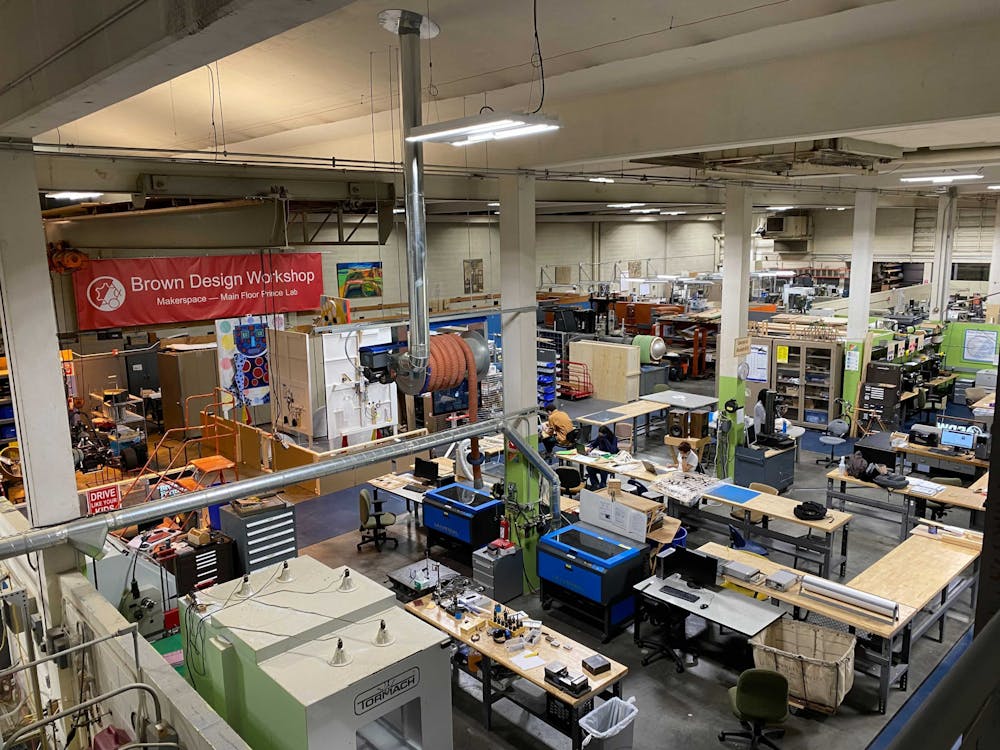When it comes to studying design, students at Brown have historically had to try taking Rhode Island School of Design classes or to pursue Independent Concentrations.
But soon, the University may offer an option to study design through the engineering department. The Design Engineering Committee — a group of engineering faculty chaired by Professor of Engineering Rod Beresford — is currently in the process of creating a design-engineering concentration.
According to committee member Iris Bahar, professor of engineering and computer science, the group was formally established in March 2020 to move forward with a proposal for a design-focused engineering curriculum. But discussions of integrating design into the engineering department have been long-running.
‘Really student driven’
While the process of getting a design-engineering concentration approved is just beginning, undergraduate students spearheaded initial conversations about integrating design several years ago.
“Number one, it was really student-driven,” said Program Director of the Executive Master in Science & Technology Leadership Michael Donohue, who teaches ENGN 0032: “Introduction to Engineering: Design,” a course introduced in fall 2020.
In 2018, 10 students proposed incorporating design under a Departmental Independent Study Project, Beresford added. Eight of these students went on to create Design@Brown. Briana Das ’21, one of the original members of Design@Brown, defined the student group as “fundamentally a Departmental Undergraduate Group but for design.”
Design@Brown helped students navigate Independent Concentrations in design by, for example, helping them decide what classes to take, but soon realized they needed more infrastructure for studying design at the University.
“A lot of advocacy had to be done within an actual department. Changes had to be made within the formal college curriculum, and not just … in these informal student-run settings,” Das said.
When they first presented their ideas to the School of Engineering, Das said that they weren’t “met with the greatest of receptions.”
“There was general resistance to change the way engineering has been thought of historically at Brown. Design can often feel like, ‘Oh, that’s a RISD thing,’” when really, she explained, design is an “interdisciplinary craft that in many ways is built for a school like Brown.”
Despite its apprehensive reception, Design@Brown wrote a 63-page proposal for how design could come to Brown that recommended creating ENGN 0032 and a design B.A. concentration.
ENGN 0032: A ‘design process’ in itself
When the DISP presented its ideas for a design-engineering curriculum at an engineering faculty meeting January 2019, Donohue approached the group about his interest in teaching a design class.
“The students presented this idea (for ENGN 0032), which I just absolutely loved, and I said, ‘Hey, if you need somebody to teach one of these classes, I’d be happy to help,’” he recalled. The class, he continued, was the first “baby step” into pursuing the group’s initiatives.
While student interest for design engineering has existed for some time, the creation of and interest in ENGN 0032 really indicated the need for design to be integrated into the engineering department, Das said.
“We’ve seen a shift in student interest in more design related opportunities,” said Chris Bull, director of the Brown Design Workshop.
While ENGN 0032 was only created last fall, this semester, over a third of students in introductory engineering courses “chose the ENGN 0032 option, which has more of that design flavor,” Beresford added.
Ultimately, work on creating the design engineering concentration is proceeding “because kids have wanted one for years,” said Deb Mills-Scofield, a member of the Design Engineering Committee.
Angela Baek ’24, a Herald designer and an ENGN 0032 teaching assistant, appreciated the unique class structure and its focus on design.
“It was really different from every other class I’ve ever taken,” she said. “First of all, (there are) no tests or exams. It’s all project based, homework is designed to focus on … the design thinking process, which is a lot different than anything else I’ve ever learned at school.”
Faculty have also found that the class attracts more diverse students from varying disciplines and backgrounds.
“(ENGN 0032) is just the best way to bring in the most people in the most accessible and inclusive way,” said Dana Kurniawan ’22, a teaching assistant in the class.
Donohue also noted that the class has garnered strong interest from people of color, and a majority of the students are women. Of the 21 TAs, he said, 16 are women.
Now in its third iteration, the class is being taught in person for the first time and has gone through a number of changes. Twenty-one TAs teach a class of 80 students, and many of the TAs have provided their feedback to Donohue about how to make the class better.
“He’s done a fantastic job of collecting feedback,” Kurniawan said. “We want to create a class challenging enough that (it) will give you a great primer to engineering, as great as ENGN 0030 will provide, with more flexibility for cool projects.”
The iterative process of changing and trying new things in the classroom is itself a practice in design thinking, Donohue remarked. “ENGN 0032 is a textbook design process.”
A look into the concentration
If you think about the kind of engineering degree Brown should offer, Donohue said, “this is it.”
“It’s so unique to have people that can operate in the engineering world or in the STEM world, and then also in the art world,” he said. “Here at Brown we attract those types of people because of the open curriculum. They’re like, ‘I just want to explore.’”
The Design Engineering Committee hopes that the new concentration will offer students a more design-focused, interdisciplinary and flexible option.
“Most engineering students are doing” one of the B.S. concentrations, Beresford said. “These are ABET accredited degrees” with “heavy course loads that are basically all STEM courses. One of the big changes or points of difference with a design engineering concentration would be that a significant part of it would draw in other disciplines.”
While the design-engineering B.S. will likely have core requirements similar in function to existing engineering options, it will also “integrate courses that have more social science elements,” Bahar said.
The flexibility and the ability to “draw from other areas within Brown” is what makes it different from other engineering disciplines at the University, and what will ultimately further augment students’ education, Donohue said.
What would really set the design-engineering concentration apart from an independent concentration in design, or focusing on design within existing concentrations, would be having an early emphasis on design, Baek said. While figuring out potential concentrations in her freshman year, she found that most students would only start studying design through a capstone during their third or fourth year.
“With 0032, it just helps that you’re introduced to design early on, so you actually know that that’s something you want to do. And I think the engineering design concentration does the same thing — it brings something that is kind of ‘gatekept’ at the end of the engineering path and it brings it toward the front so you have more experience with it throughout your four years,” Baek said.
Kurniawan added that the concentration would provide much-needed structure for those interested in pursuing design. “The first thing is that there is no home or umbrella for people who would like to get into design more. … If people come in to study design at Brown, they’re gonna find it really difficult to take (RISD) classes.”
As part of the concentration, students would likely also choose an upper level pathway, modeled after the computer science department’s upper level pathways, Donohue said. Some pathways that have been discussed include architecture and urban planning, energy and sustainability, user interface and user experience, healthcare, industrial design and interactive computing.
“Students could follow in some of those pathways or they might create something of their own,” Beresford said. “What we’re really trying to do here is make a more flexible (B.S.)” Beresford added, “the existing ones are quite prescribed … it becomes pretty programmed.”
In addition to pulling from existing social science, STEM and engineering classes, the Design Engineering Committee hopes to add a few new classes to the curriculum.
According to Mills-Scofield, the committee is currently considering three classes: one on systems thinking, one on the design brief and one on UI/UX design.
“Most of the design-engineering-interested kids want to understand this system and the bigger picture,” Mills-Scofield said. For instance, in looking at building an electric vehicle, you might not only consider chemical, material and electrical engineering, but also the political science, economics and cognitive science that goes into the designing and the decision making process, she added.
The committee believes that a design-engineering concentration could also cater to a larger pool of students. Beyond that, Mills-Scofield believes that based off the data from ENGN 0032, the design-engineering concentration may likely be more diverse and broadly appealing than the existing options.
While the planned design-engineering B.S. concentration will not be officially ABET accredited, most faculty agree that it would still readily equip students for any post-undergraduate career.
“I’m seeing … with my clients and companies, more and more of them are no longer having the standalone engineering department and design department,” Mills-Scofield said. Having a design-engineering concentration equips students to speak in both the design and engineering languages and enter anything from product design to UI/UX design to industrial design, she added.
Nevertheless, the proposal is still in the works and needs to meet several steps before the concentration can be offered.
According to Donohue, the proposal needs to be approved by the School of Engineering faculty and the Class Curriculum Council. At the moment, the committee is focused on creating a presentation for the Engineering Executive Board.
While the faculty will likely hear the proposal within the next month, according to Beresford, it’s difficult to predict when it will officially be passed. Donahue said he predicts the concentration will be offered by the spring.
The fact that the concentration hasn’t been announced “doesn’t mean that students can’t take courses … in preparation,” Bahar said.
She recommends interested students start taking some classes in the engineering core and social sciences. That will “put you in a good position.”
Baek said she hopes to pursue the industrial design track along with an additional concentration in visual arts.
“I plan on declaring it when it is approved,” she said. “Hopefully, it’s a ‘when’ and not ‘if.’”

Gaya Gupta was Senior Editor of Digital News for the 132rd Editorial Board. She previously covered diversity on campus. She is a junior from the San Francisco Bay Area studying computer science and English.





